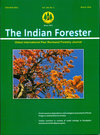Carbon Accumulation and Partitioning in Sub-Humid Forest Stands of West Bengal India
DOI:
https://doi.org/10.36808/if/2018/v144i3/122749Keywords:
Carbon Sequestration, Forest Carbon, Biomass, Reserve Forest.Abstract
The present study was conducted at Chilapatta Reserve Forest under Cooch Behar Wildlife Division in Terai zone of West Bengal. The study was aimed to analyze the carbon stock and its accumulation in different components of various floristic layers including trees, herbs and shrubs based on dominant species/stands. The dominant stands selected were Lagerstroemia parviflora, Shorea robusta, Tectona grandis and Michelia champaca. Aboveground biomass and carbon accumulation was estimated for all these stands. The majority of the contribution to biomass and carbon of the different stands was contributed by the trees (99 %) while a negligible amount was contributed by shrubs (0.25 %) and herbs (0.06 %). Stems were the dominant contributor toward biomass accumulation followed by branches, roots, leaves and foliage in the trees.References
Brown S.A.J., Gillespie J.R. and Lugo A.E. (1989). Biomass estimation methods for tropical forests with application to forest inventory data. Forest Science, 35: 881-902.
Champion H.G. and Seth S.K. (1968). A Revised Survey of the Forest Types of India. Govt. of India Publications, New Delhi, India.
Chidumayo E.N. (1990). Above-ground woody biomass structure and productivity in a Zambezian woodland. Forest Ecology and Management, 36: 33-46.
Giril A., Aryal B., Bhattaraiz B., Ghimire S.K., Shrestha K.K. and Jha P.K. (1999). Vegetation Composition, Biomass Production and Regeneration in Shorea robusta Forests in the Royal Bardia National Park, Nepal. Nepal J. Science and Technology, 1: 47-56.
Jandl R., Lindner M., Vesterdal L., Bauwens B., Baritz R. Hagedorn F., Johnson D.W., Minkkinen K. and Byrne K.A. (2007). How strongly can forest management influence soil carbon sequestration? Geoderma, 137: 253-268.
Jha K.K. (2015). Carbon storage and sequestration rate assessment and allometric model development in young teak plantations of tropical moist deciduous forest, India. J. Forestry Research, 26: 589-604.
Kaul M., Mohren G.M.J. and Dadhwa V.K. (2010). Carbon storage and sequestration potential of selected tree species in India. Mitigation and Adaptation Strategies for Global Change, 15: 489-510.
Kinderman G., Obersteiner M., Sohngen B., Sathaye J., Andrasko K., Rametsteiner E., Schlamadinger B., Wunder S. and Beach R. (2008). Global cost estimates of reducing carbon emissions through avoided deforestation. Proceedings of the National Academy of Sciences, 105: 10302-10307.
MacDicken K.G. (1997). A Guide to Monitoring Carbon Storage in Forestry and Agroforestry Projects. Winrock International Institute for Agricultural Development, Kenya.
Mandal G. and Joshi S.P. (2014). Biomass accumulation and carbon sequestration potential of Shorea robusta and Lantana camara from the dry deciduous forests of Doon Valley, western Himalaya, India. Inter. J. Environmental Biology, 4: 157-169.
Mandal R.A., Yadav B.K., Yadav K.K., Dutta I.C. and Haque S.M. (2013). Development of Allometric Equation for Biomass Estimation of Eucalyptus camaldulensis : A study from Sagarnath Forest, Nepal. Inter. J. Biodiversity and Ecosystems, 1: 1-7.
Pan Y., Birdsey R. A., Fang J., Houghton R., Kauppi P. E., Kurz W. A., Phillips O. L., Shvidenko A., Lewis S. L., Canadell J. G., Ciais P., Jackson R. B., Pacala S. W., McGuire A. D., Piao S., Rautiainen A., Sitch S. and Hayes D. (2011). A large and persistent carbon sink in the world’s forests. Science, 333: 988-993.
Paul S.C. (2004). Land use effects on soil characteristics of Terai region of West Bengal., 58. West Bengal: Uttar Banga Krishi Viswavidyalaya.
Poorter L., Bongers F., Aide T.M., Almeyda Zambrano A.M., Balvanera P., Becknell J.M., Boukili V., Brancalion P.H.S., Broadbent E.N., Chazdon R.L., Craven D., de Almeida-Cortez J.S., Cabral G.A.L., de Jong B.H.J., Denslow J.S., Dent D.H., DeWalt S.J., Dupuy J.M., Durán S.M., EspÃrito-Santo M.M., Fandino M.C., Césa, R.J., Hall J.S., Hernandez-Stefanoni J.L., Jakovac C.C., Junqueira A.B., Kennard D., Letcher S.G., Licona J.C., Lohbeck M., MarÃn-Spiotta E., MartÃnez-Ramos M., Massoca P., Meave J.A., Mesquita R., Mora F., Muñoz R., Muscarella R., Nunes Y.R.F. Ochoa-Gaona, S., de Oliveira, A.A., Orihuela-Belmonte, E., Peña-Claros, M., Pérez-GarcÃa E.A., Piotto D., Powers J.S., RodrÃguez-Velázquez J., Romero-Pérez I.E., RuÃz J., Saldarriaga J.G., Sanchez-Azofeifa A., Schwartz N.B. Steininger, B.K., Swenson, N.G., Toledo, M., Uriarte, M., van Breugel, M., van der Wal H., Veloso M.D.M., Vester H.F.H., Vicentini A., Vieira I.C.G., Bentos T.V., Williamson G.B. and Rozendaal D.M.A. (2016). Biomass resilience of Neotrop cal secondary forests. Nature, 530: 211-214.
Shanin V., Komarov A. and Mäkipää R. (2014). Tree species composition affects roductivity and carbon dynamics of different site types in boreal forests. European J. Forest Research, 133: 273-286.
Shukla G., Biswas R., Das A.P. and Chakravarty S. (2014 ). Plant diversity at Chilapatta reserve forest of Terai Duars in sub-humid tropical a foothills of Indian eastern Himalayas. J. Forestry Research, 25: 591-596.
Shukla G., Pala N.A. and Chakravarty S. (2014 ). Carbon, litter and nutrient status in teak stands of a foothill forest in Indian eastern b Himalayas. J. Tree Sciences, 33: 24-32.
Shukla G. and Chakravarty S. (2014). Cause, pattern and consequences of understorey herbaceous vegetation at a foothill forest in Indian eastern Himalayas. Indian Forester, 140(4): 354-362.
Shukla G. and Chakravarty S. (2012). Fern diversity and biomass at Chilapatta reserve forest of West Bengal Terai Duars in sub-humid tropical foothills of Indian eastern Himalayas. J. Forestry Research, 23: 609-613.
Upadhyay T.P., Sankhayan P.L. and Solberg B. (2005). A review of carbon sequestration dynamics in the Himalayan region as a function of land-use change and forest/soil degradation with special reference to Nepal. Agriculture, Ecosystems and Environment, 105: 449-465.
Woomer P.L. (1993). The impact of cultivation on carbon fluxes in woody savannas of uouthern Africa. Water, Air, and Soil Pollution, 70: 403-412.
Downloads
Downloads
Published
How to Cite
Issue
Section
License
Unless otherwise stated, copyright or similar rights in all materials presented on the site, including graphical images, are owned by Indian Forester.





